Investopedia's my go-to site for showing off SEO best practices.
They're particularly impressive because finance is a YMYL space, which must pass strict Google guidelines on trust and authority.
And, yet, they still dominate.

In this article, I'm going to break down five reasons behind their success:
- They stay in their lane
- Content volume and freshness
- Best practice blog templates and site structure
- E-A-T signals
- Backlink profile
We'll deep dive each of these with additional examples and analyses.
1/ They Stay in Their Lane
Investopedia's focus is incredibly narrow. They write consistently about one topic: financial advice.
This is called topical authority.
This strategy allows even low-domain authority sites to rank for competitive keywords.
It's simple when you think of it like this. Would you rather read a blog post on snowboarding by Amazon.com or xgames.com? Despite Amazon's high authority, this just isn't their area of expertise. Google knows that.
One further benefit of building topical authority is that it allows for more natural interlinking.
Let's take a quick look at this in action with Investopedia:
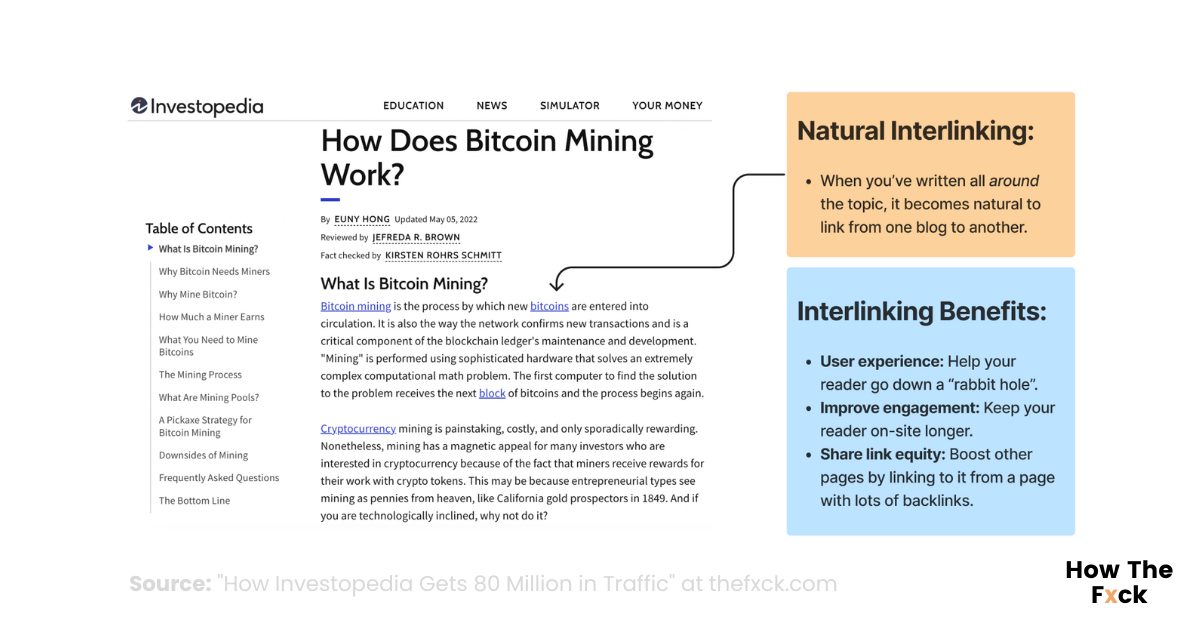
There are several benefits to interlinking, as noted in the image. One further benefit is to improve Google's crawl efficiency.
Wondering if you've got topical authority?
Kevin Indig recently wrote his method for measuring topical authority. He suggests that a proxy for topical authority is "Topic Share". The most 'authoritative' site for a topic gets the highest share of traffic from that topic's keywords.
"The logic is that the more traffic a site gets from the keywords in a topic, the more authoritative it is for that topic."—Kevin Indig
I tested this methodology out for the parent "Personal Finance", one of Investopedia's target clusters.
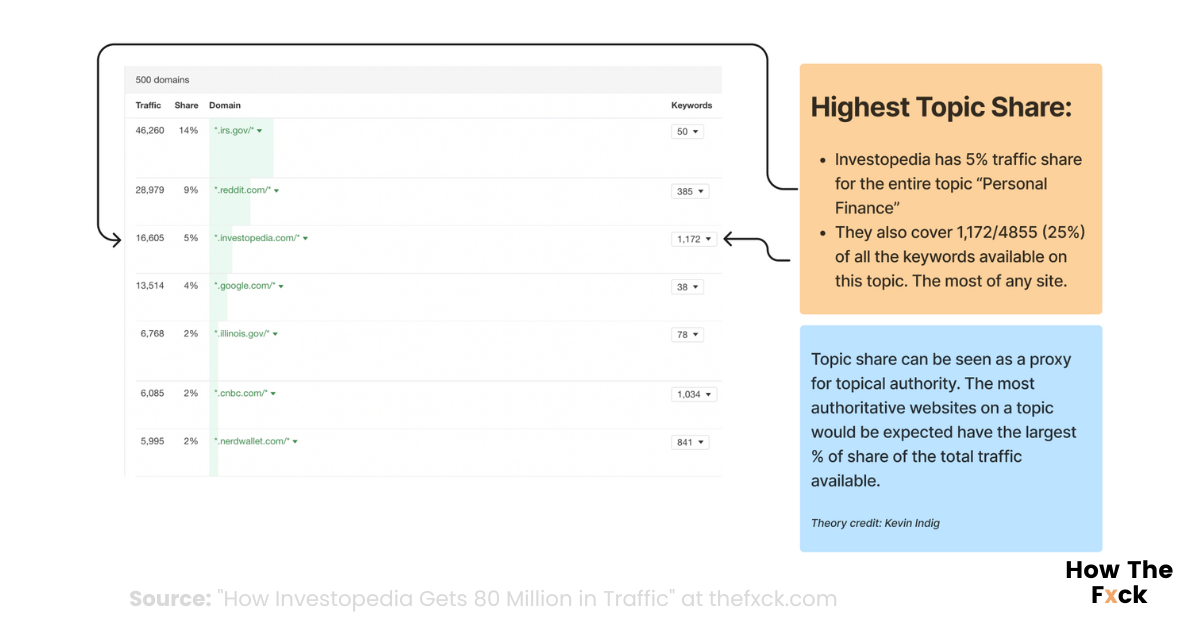
From the 4,855 available keywords using the term "Personal Finance" with volume >10, Investopedia ranks for 25% of them and wins 5% of the total available traffic.
Test it yourself, Google "personal finance". Investopedia ranks #1 for it, but clearly overall they do not beat the sheer authority of the IRS and the volume covered by user-generated content at reddit.com/r/personalfinance.
2/ Content Volume and Freshness
One of the most unbeatable strategies in SEO is a long, consistent trudge to the top. Sorry, but you can't escape it.
While domain age itself does not impact ranking (confirmed below), older URLs typically have had more time to gather backlinks, get crawled more, and have likely been updated and improved.
No, domain age helps nothing.
— John Mueller is mostly not here 🐀 (@JohnMu) July 5, 2019
Investopedia has been writing about this topic for well over eight years, consistently releasing new content.
In fact, they have around 37,000 pages on the topic of finance. That's an additional +2,000 every 18 months.
With 35,000+ pages, publishing another 2,000+ per year would be aggressive for a non-news site (Investopedia has both evergreen and financial news sections).
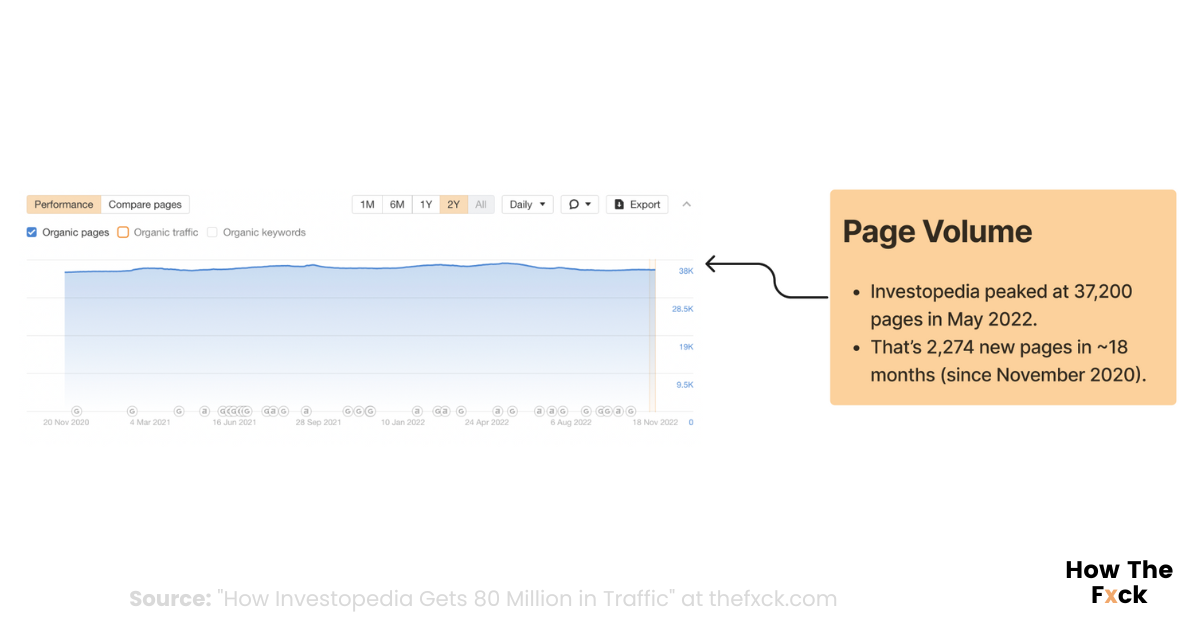
However, newer terms, like those appearing around cryptocurrencies, as well as terms like "best online brokers" are impacted by Google's freshness algorithm.
You may be wondering, does publishing volume or frequency matter for an evergreen blog? Or could I write 1,000 evergreen articles and just leave them alone?
There doesn't seem to be much definitive research on the topic. Anecdotally, Neil Patel says it does in this Quora post. However, other comments make a more logical point: for Google to base its ranking of Evergreen content on freshness makes no sense.
In my own experience, adding new content has led to uplifts in traffic on other blog posts, too. However, I would argue this is more the result of additional internal linking which led to better signals like crawlability and engagement.
Besides freshness, the main takeaway here is that Investopedia's sheer volume of content is fundamental to achieving 80 million in traffic.
You could not do that with a handful of pages.
3/ Best Practice Blog Templates and Site Structure
Investopedia's site structure is fairly neatly done. But their blog reader experience is where the site really stands out.
URL Structure
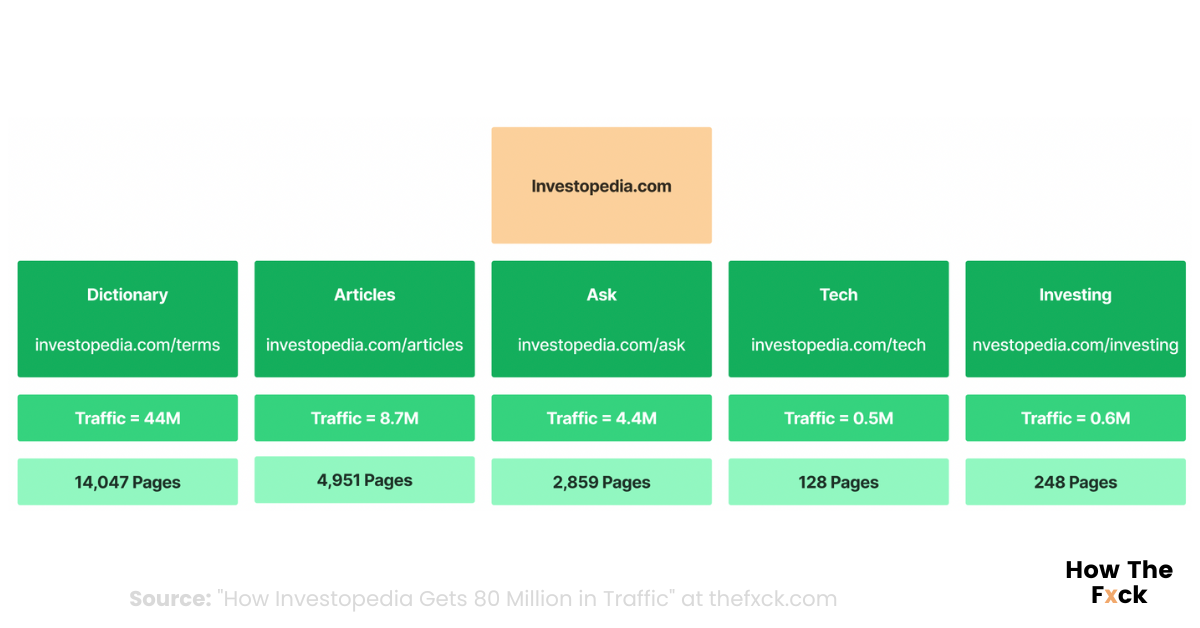
The majority of Investopedia's traffic comes from their /terms/ and /articles/ sections. The rest is then split into different sections with super clear bucketing around topics.
Investopedia's Dictionary: 44 Million Monthly Visitors
One of my favorite high-growth plays of the moment is the dictionary or glossary.
Investopedia earns upwards of 44 million in traffic from the A-Z digital library of business terms. Incredibly, they don't just provide a 50-100 description of each term, the majority of dictionary terms have +2,000 words and a thorough on-page SEO structure.
I see this mimicked around the web, for example, in Gartner's Glossary, which ranks #1 for thousands of keywords. Gartner even ranks #1 for keywords like "business development representative" (8.7K global volume), "pain points" (27k global volume), and "channel partner" (7.6k global volume) among many others. They do so with just 20-30 word definitions on each page.
How a Superior Reader Experience Helps
I recently redesigned the CustomerGauge blog template together with our internal designers, taking several best practices from Investopedia.
We saw a 22% increase in session duration and pages per session is up 15% already.
The thing I love most about their designs is that they deliver clarity, quickly. Despite in-depth, lengthy content, their blog design highlights the key points from the top.
Here are my favorite highlights and why they make sense:
- Table of Contents (ToC)
ToCs are important for a number of reasons.
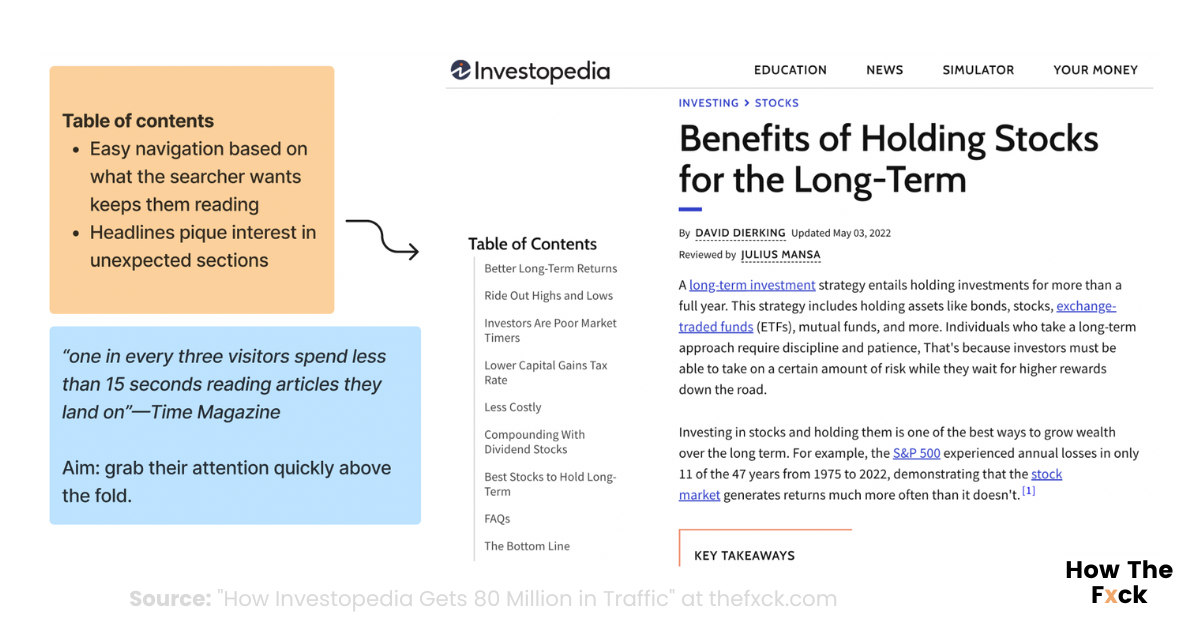
Firstly, they make navigating faster. It's important to remember that one blog post usually is shown to readers with wide-ranging search intents.
Take this blog post for example. This is Investopedia's guide to Cryptocurrency:
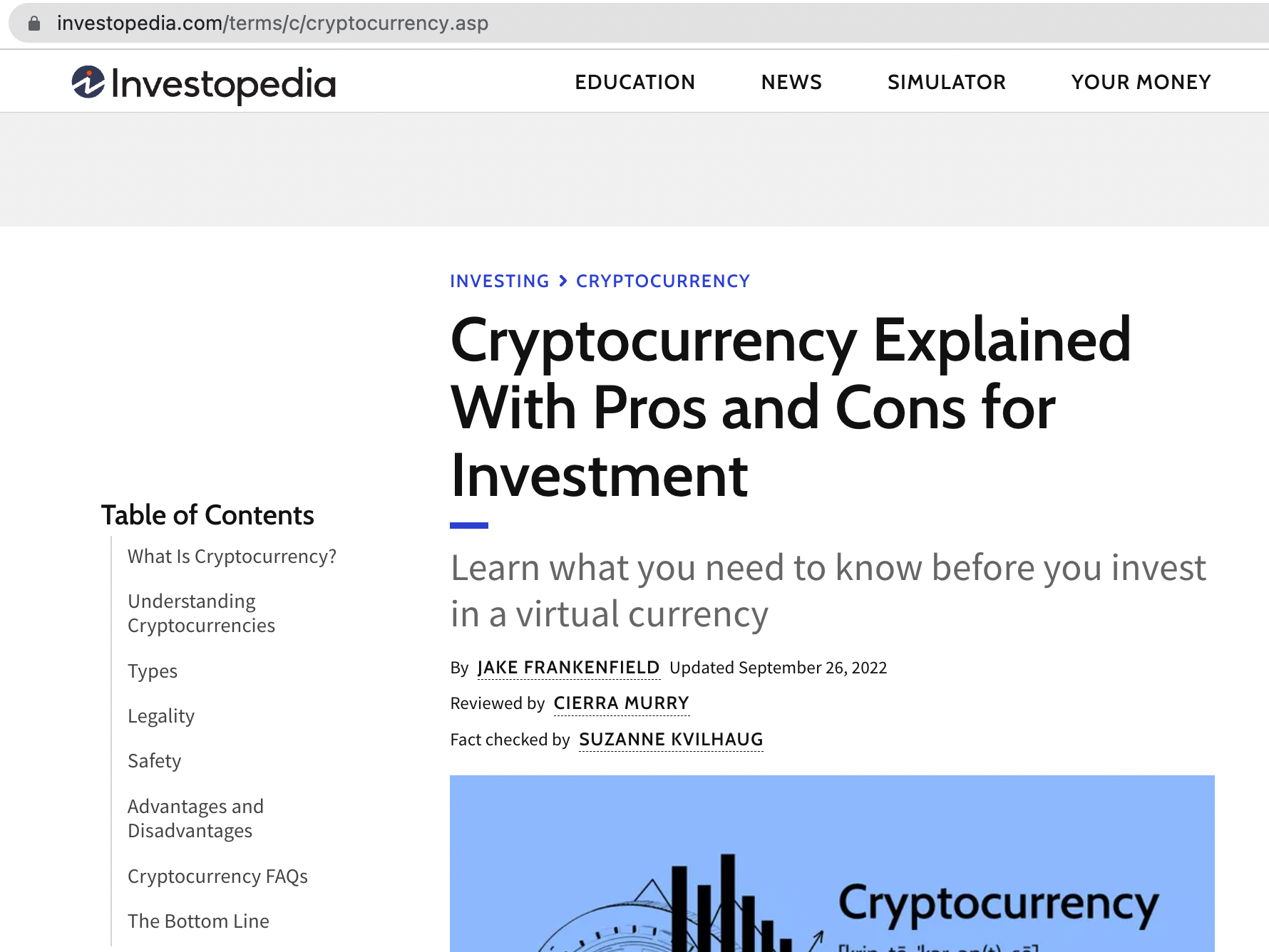
Keyword: "what is crypto" (72k traffic potential) brings me to this blog post
Keyword: "why use cryptocurrency" (20k traffic potential) also brings me to this blog post.
The search intent behind these keywords is very different. Yet one article ranks #1 for them.
This is where a ToC comes to the rescue. Both these searchers can immediately skip to the section of the article that's relevant to their search, reducing immediate bounces and improving session duration.
A ToC also helps the reader discover new parts of an article. Instead of wading through 2,000 words, or, most likely, skimming down headlines, the reader can simply skim the ToC to:
- See if a point is made they haven't heard of before
- See if a particular section pertains to what they're looking for specifically
Both improve engagement and session duration, a win for your reader's experience and your SEO.
2. Key takeaways
Key takeaways serve a similar purpose to the ToC. They decrease the time to value of the article and, therefore, improve engagement and time-on-page.
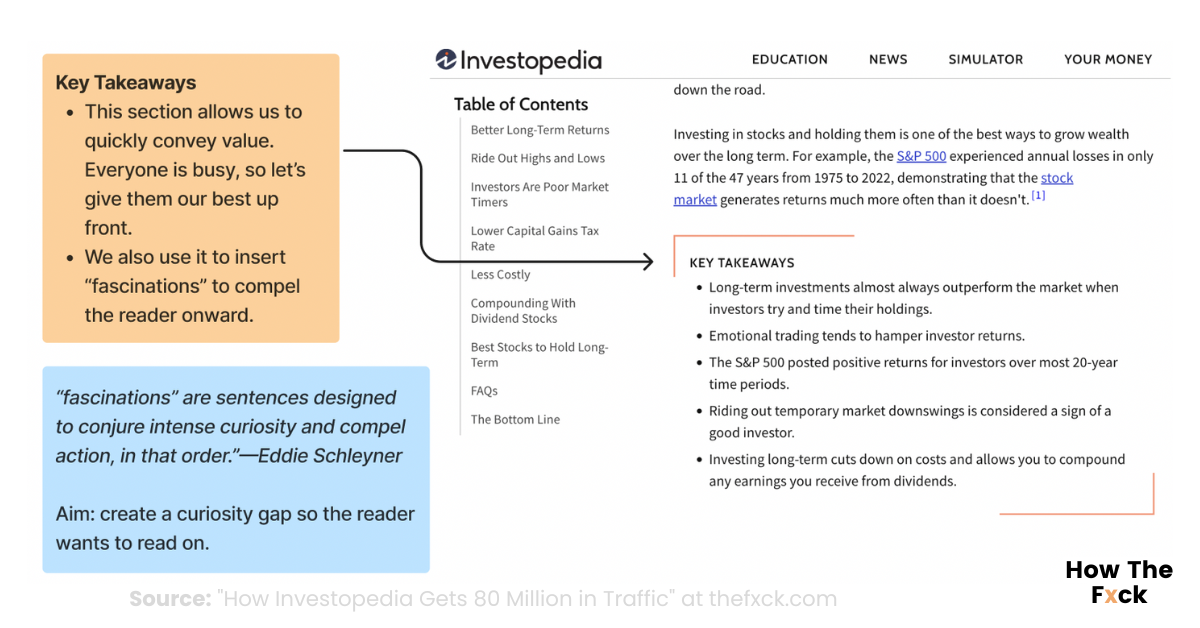
More than anything, it's simply a great reader experience. We're all busy and welcome a synopsis at the top of the page.
This style also fits the communications framework used at McKinsey Consulting, which advocates for the Pyramid Principle.
The Pyramid Principle was created by Barbara Minto at McKinsey as a method of structuring communications for maximum impact. The idea is to start with your main idea, and then use logically grouped arguments to support your position.

Efficient communication prioritizes the reader getting to the key value points, fast.
Investopedia adding key takeaways to their content prioritizes efficient communication, improving the value a piece of content delivers.
3. Other on-page experiences
Investopedia peppers its content with positive reading experiences.
Here are a few examples.
Fast Facts:
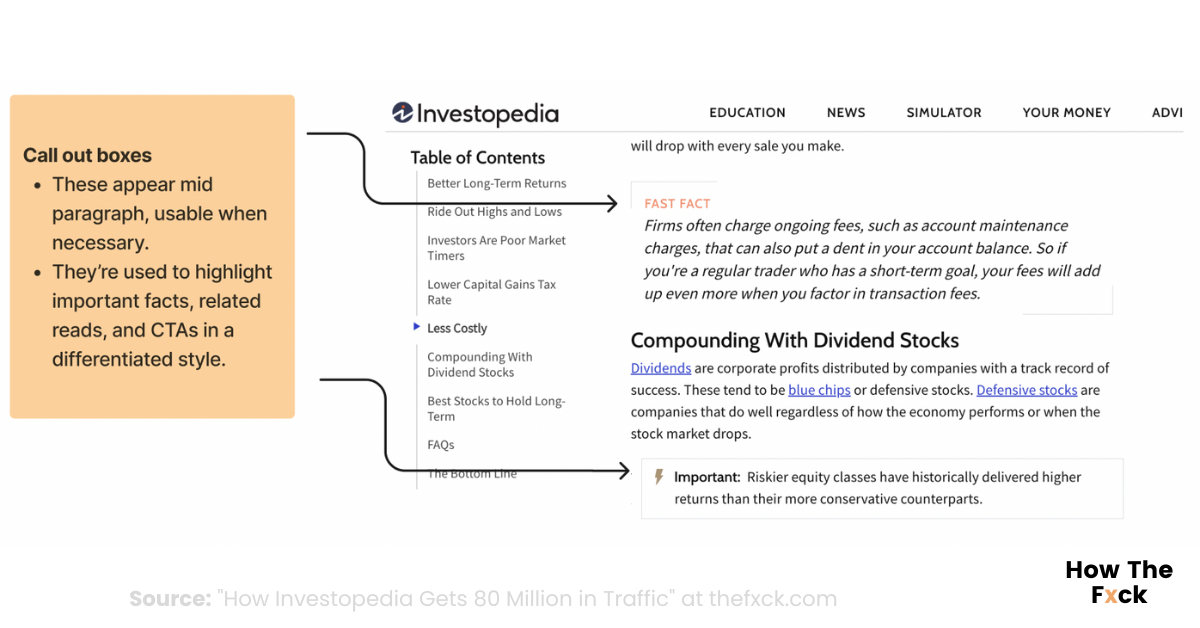
They have "call-out" boxes that are flexible to the needs of the writer. As you can see in the example above, they're used strategically to drive a point home or add clarity.
Interactive Calculators:
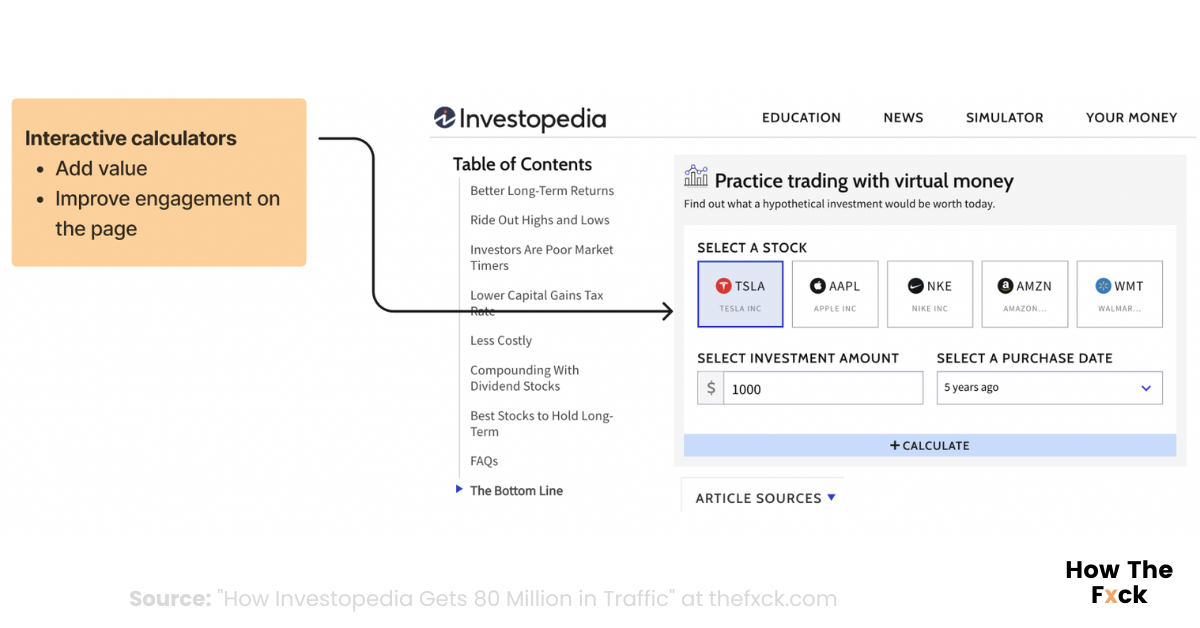
Investopedia uses interactive calculators to help the reader engage with content (increasing session duration) and improve the value the content provides.
On top of this, they frequently use interactive, real-time stock graphs and video explanations of points.
Passing Core Web Vitals ✅
Despite the interactivity and complicated templates, Investopedia passes core web vitals.
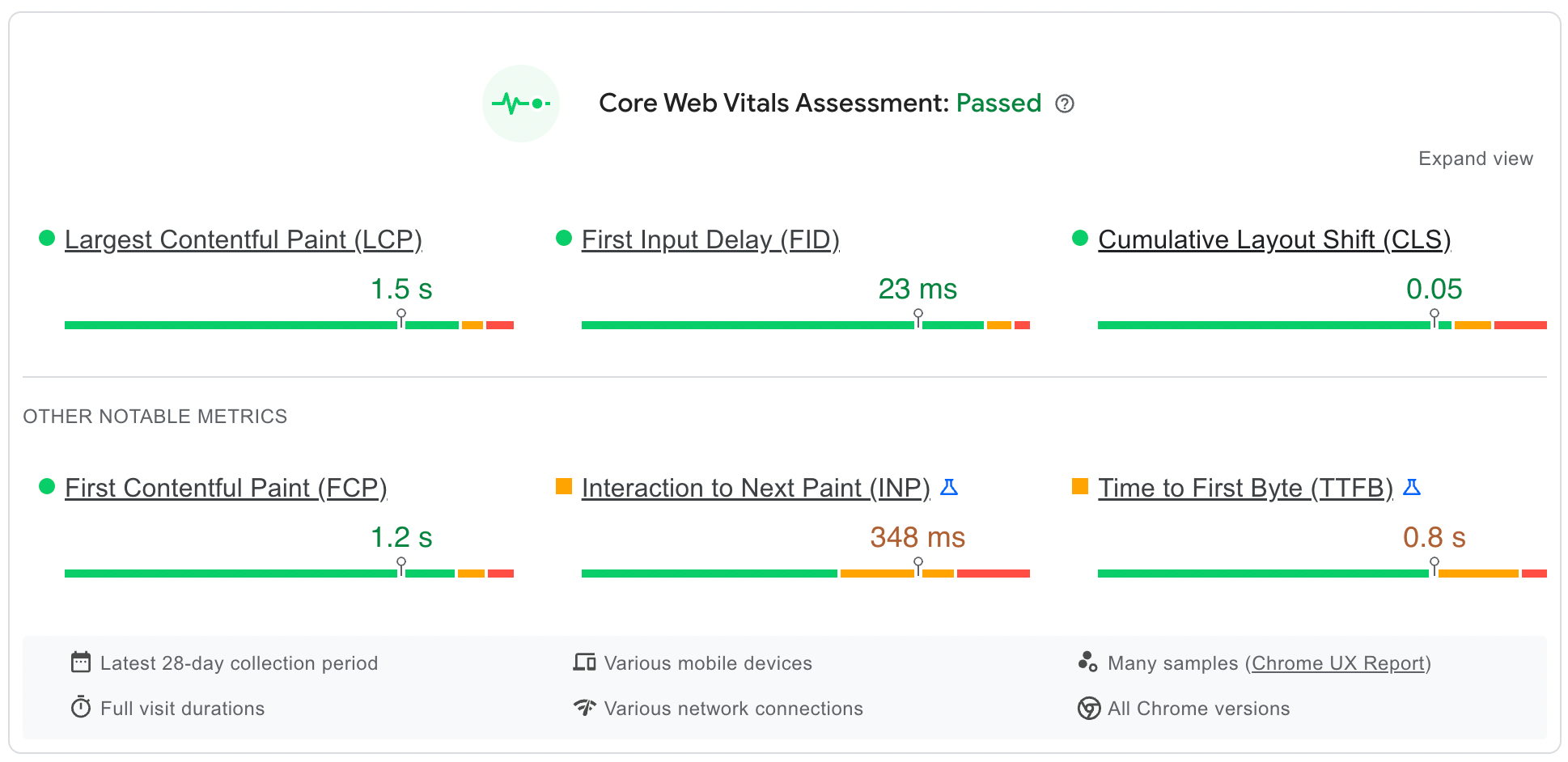
Here are the three Core Web Vitals Google is monitoring:
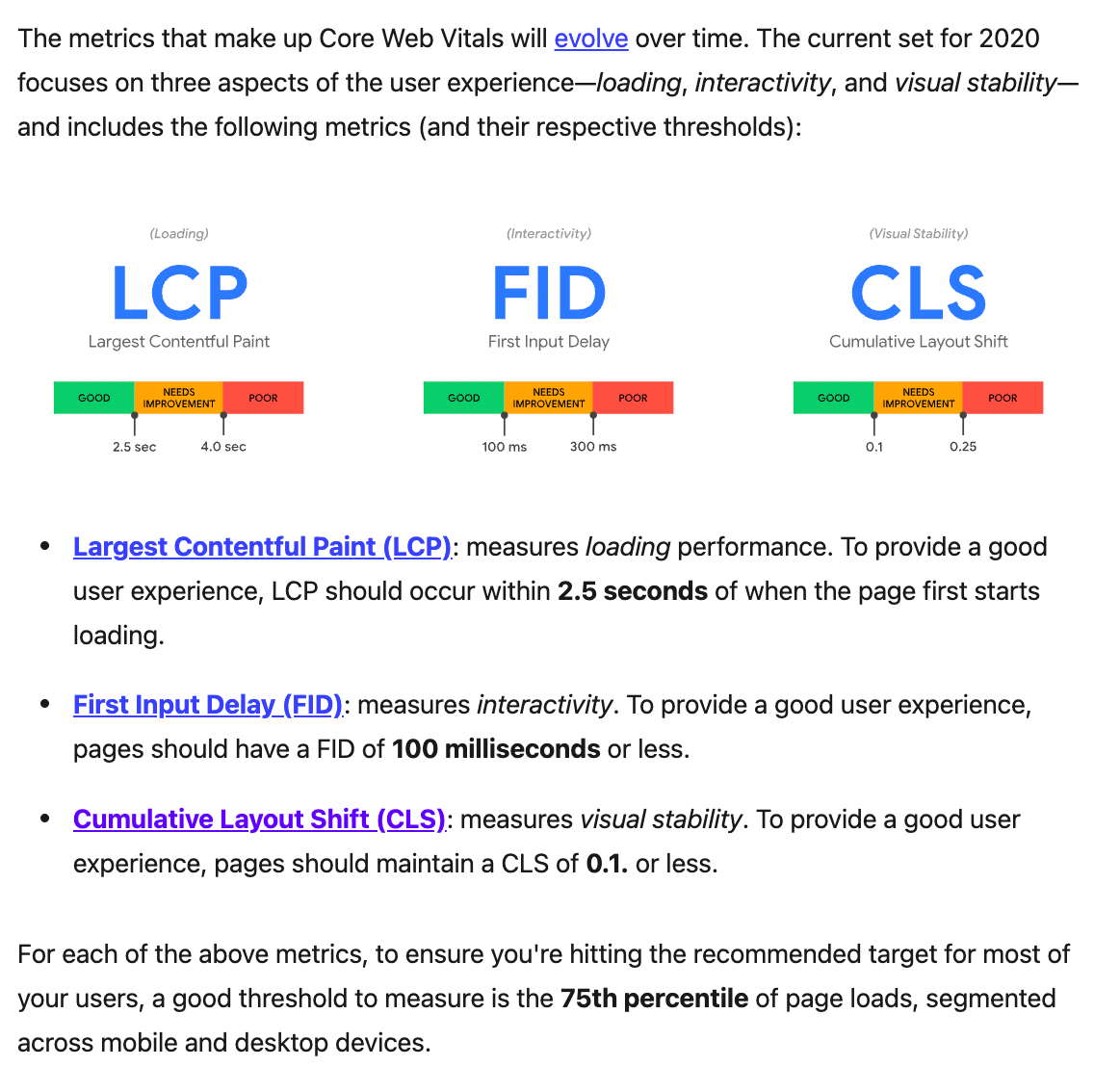
4/ Expertise-Authority-Trust (E-A-T) Signals
E-A-T is essential for financial websites.
Your Money Your Life (YMYL) was set up by Google to cover sectors like healthcare and financial well-being. It's essentially a stricter requirement placed upon sites in these niches because misinformation could lead to serious health impacts for users.
Let's look at what Investopedia does to convey E-A-T to Google.
- The writers
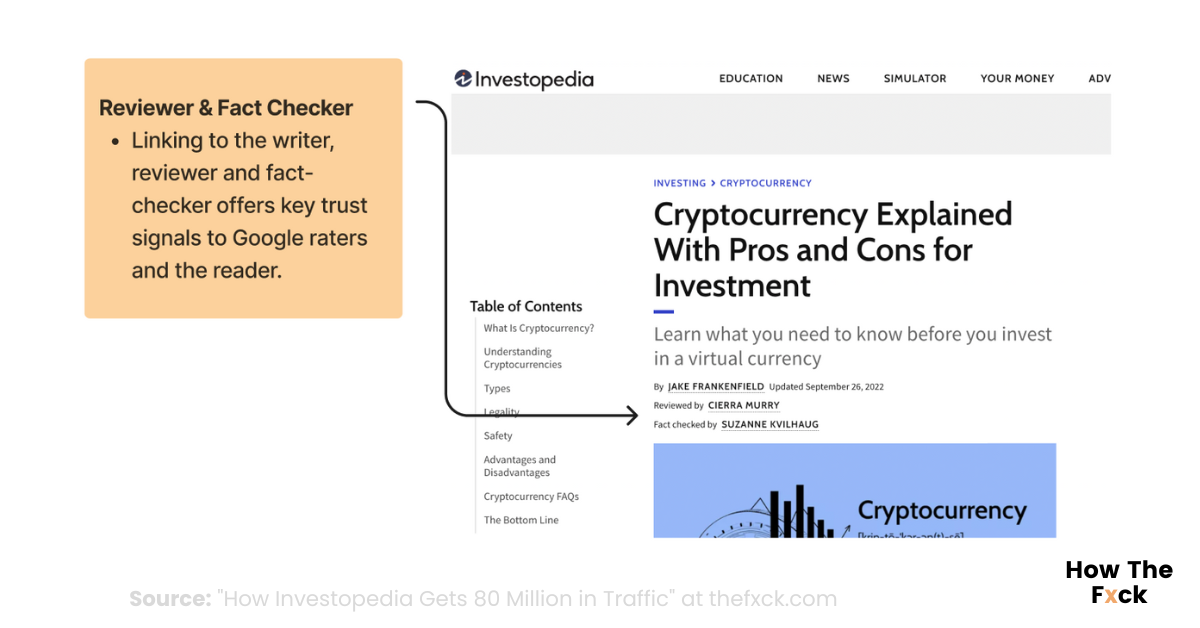
Not only does every Investopedia article show the author (a lot of websites I review even miss this), but they show both a reviewer and a fact-checker.
That's an incredible amount of work, which shows their team is fully aware of the importance of accurate content in the YMYL space.
2. The sources & editorial policy
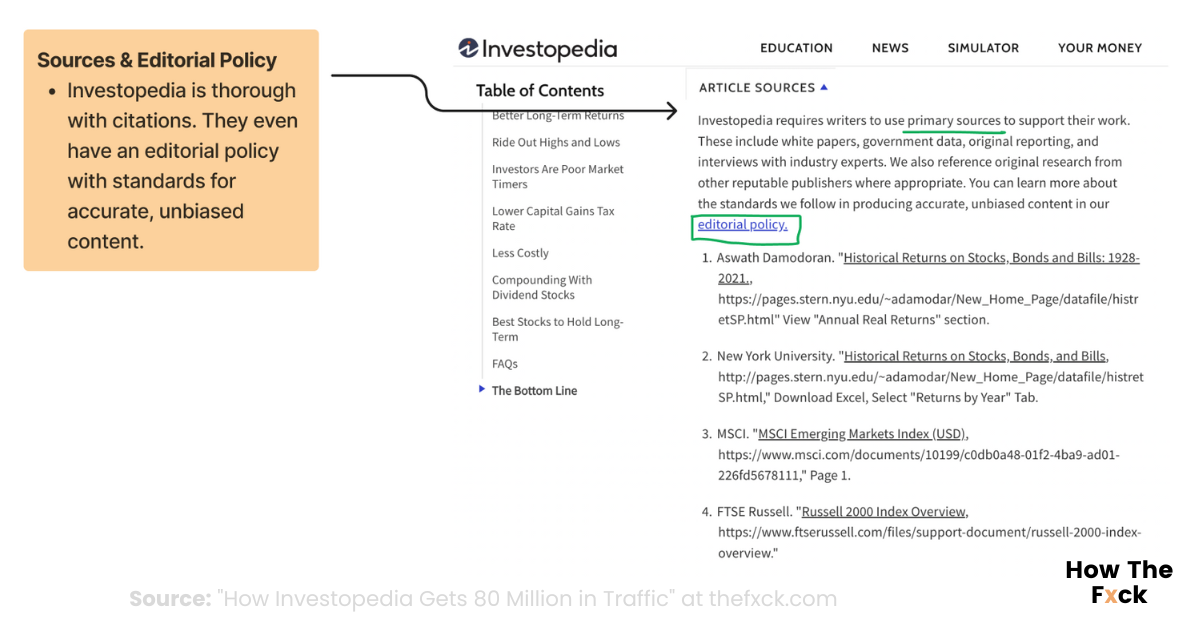
Many sites include sources or, at least, backlink to them where appropriate. But Investopedia goes much, much further.
They always cite primary research and government sources and they do so using Academic standards.
Furthermore, they have an editorial policy and make it clear to the writer (and Google's human reviewers) that their content is as accurate and thought out as it can be.
3. Freshness & updating
In YMYL, so much as a broken or outdated source link could tank your search rankings.
Content updates are a full-time job in this space. If new data comes out that disproves old, then it needs to be incorporated quickly.
5/ Backlink Profile
Whether you like it or not, backlinks are extremely important to ranking in competitive niches.
They're just one of the many ranking factors, Google places high value upon them.

But, let's reiterate. Not all backlinks are created equal.
A single high-quality link can be worth more than 1,000 low-quality links.
Here's Investopedia's backlink profile:
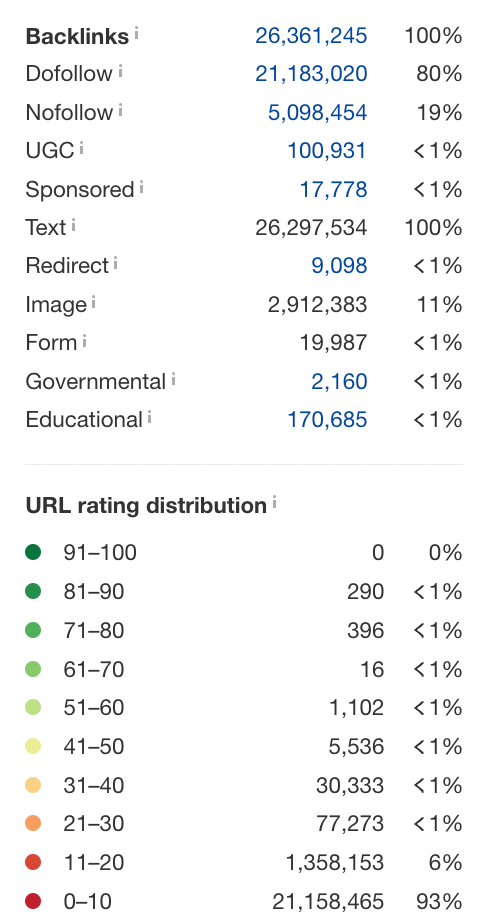
What we're looking for here is DoFollow backlinks (they have 21 million) and URL rating distribution. In this example, less than 1% of Investopedia's links come from domains with an 81-90 score.
But those backlinks come from sites like:
- coindesk.com
- ethereum.org
- newscientist.com
- usatoday.com
- nasdaq.com
- etoro.com
All highly relevant, high-authority websites. These backlinks alone are likely to be the most powerful ranking factor.
Overall, Investopedia's Domain Rating is 92. That puts them 368 in the global rank of all websites according to Ahrefs.
Their most backlinked pages tend to be their dictionary on investopedia.com/terms/ some of which have 1,000s of links. This is another +1 for having a glossary for your niche.


